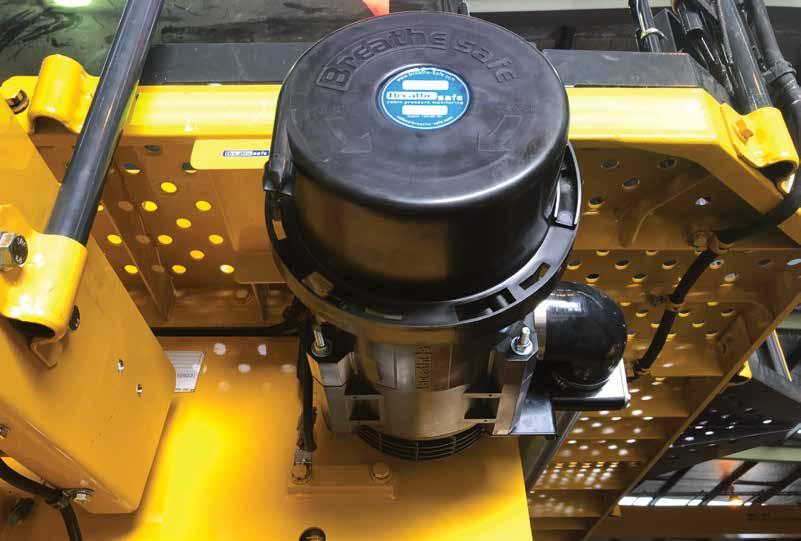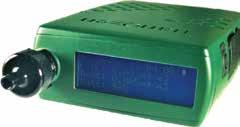
3 minute read
Next in research
Lightning strikes may penetrate deep underground, putting a mine’s integrity into question.
Alot of research on mine safety has been focused on sensors, the Internet of Things and data analytics, but lightning strikes and air quality inside mines will be the target of two leading scientists from the United States next year.
Tall mine structures, such as headframes are, indeed, preferred places for lightning to strike. While a headframe itself is assumed to be as robust, lightning currents have been shown by researchers to penetrate deep underground, according to New Mexico Tech Professor and former Silicon Valley engineer Richard Sonnenfeld.
In the United States, methane explosions in coal mines have been shown to be triggered by sparks that were induced by surface lightning.
But the phenomenon of lightning attachment – the technical term that addresses the basic question of ‘How does a lightning flash know what to hit?’ – is not well understood, leading to the impossibility to engineer better lightning protection solutions.
“Much work is empirical, (though) modern instruments have the potential to illuminate this important subject. … I hope to observe the headframes in Kalgoorlie under thunderstorm conditions,” Sonnenfeld tells Safe to Work.
Sonnenfeld and mining and metallurgical engineering academic George Danko, from the University of Nevada, will conduct research at Curtin University next year under the Fulbright program.
The initiative was established in 1949 through a binational treaty between the Australian and United States Governments, resulting in the award of about 100 scholarships each year.
Danko, on the other hand, will meet with Australian partners to develop methods for improving mine safety and health related to hazardous atmospheric conditions in mines.
By using real-time condition monitoring, evaluation and control, the methods will target early recognition of hazards produced by natural or operational causes, allowing for preventative interventions in advance.
“The rapidly shrinking workforce in modern mines and the diminishing human feedback may create new problems in manual safety examinations in the USA and worldwide,” Danko says.
“It is necessary to rely on the application of monitoring sensor networks and automatic evaluation of the signal streams for worrisome trends with fewer humans in the loop.”
The ever stricter regulations for safety and health will also require automatic monitoring and evaluation, highlighting the benefits of an early warning system (EWS) technology. TWO RESPECTED UNITED STATES SCHOLARS WILL CONDUCT RESEARCH ON LIGHTNING STRIKES AND AIR QUALITY INSIDE MINES AT CURTIN UNIVERSITY. VANESSA ZHOU WRITES.
Danko believes that running the automatic EWS in the mines and forecasting dangerous events may prevent over-ventilation while still maintaining required safety factors.
“Air quality regarding contaminant concentrations at the working places in the mines must be strictly controlled and observed according to operation permits,” he says.
“In spite of these compliance verifications, there are new roles for the EWS to play in a modern mine.”
Major organisations, such as the National Institute of Safety and Health and the Alpha Foundation for Mine Safety and Health in the United States, and the mining industry feverously pursue improvements in safety and health, according to Danko.
Australia is a leading country in realtime, mine-wide atmospheric monitoring. The automated evaluation of mine-wide conditions for safety and health, and cost benefits continuously in real-time are “missing (and) lacking the dynamic, mine-wide modelling and information technology tools,” he says.
The new tools need to be selfcalibrated by machine-learning for understanding baseline conditions during variable mining operation; be fast and accurate to recognise worrisome patterns for scrutinising for hazardous possibilities, according to Danko.
It is Danko’s aim to quantify the operating safety factors for atmospheric conditions at both monitored and unmonitored locations everywhere in the mine.
He is a lso interested in recognising suspicious events and threats in the atmospheric conditions, and “to take

a forward-look in time for possible outcomes if they likely cause problems in compromised safety.”
Further, Danko expects to report overly large operating safety factors for health that could be reduced for ventilation cost-saving without compromising safety and health conditions.
“Curtin University’s Western Australian School of Mines (WASM) has strong reputation across all aspects of mining and mineral processing industry, including mine planning and design, mineral processing and optimisation,” WASM head of school Vishnu Pareek says. “While it is coincidence that both fellows’ research is about mine safety, they will work on two different aspects. … The visits of the two Fulbright Fellow will bring greater focus to mine safety and integrity.”











